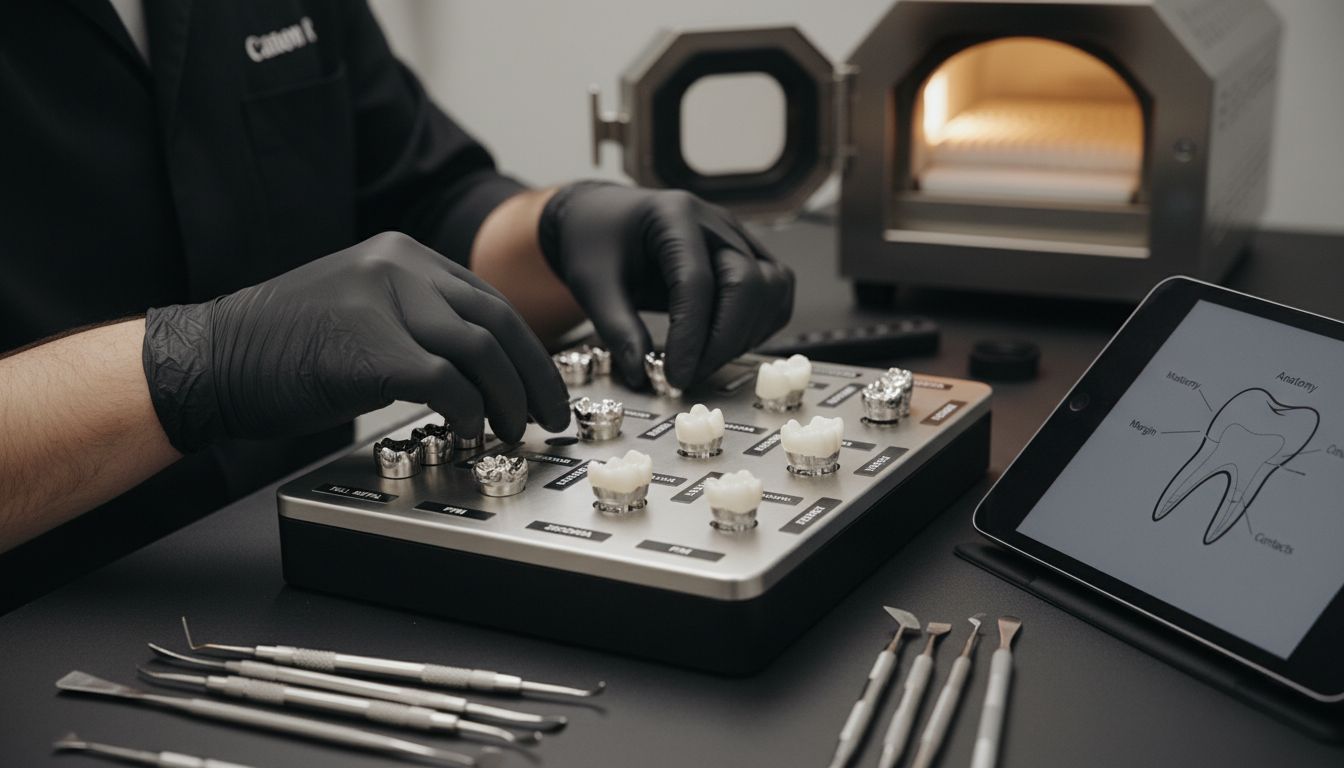
Nearly 15 million dental crowns are placed in the United States every year, showing how common this treatment has become. With so many people relying on crowns to restore their smiles, separating fact from fiction can make a real difference in dental health decisions. Discover how dental crowns work, the truths behind popular myths, and the reasons these restorations remain a trusted choice for protecting and rebuilding teeth.
Table of Contents
- Dental Crowns Defined And Common Myths
- Types Of Dental Crowns And Materials Compared
- Step-By-Step Dental Crown Procedure Explained
- Lifespan, Maintenance, And Potential Risks
- Cost Factors And Alternatives To Crowns
Key Takeaways
| Point | Details |
|---|---|
| Understanding Dental Crowns | Dental crowns are custom restorations that restore the function and appearance of damaged teeth, offering options in various materials for different needs. |
| Longevity and Maintenance | With proper care, dental crowns can last 10-15 years, but regular dental check-ups and good oral hygiene are essential for prolonging their lifespan. |
| Cost-Effectiveness | Although crowns may have higher initial costs, they can be more economical in the long term compared to other dental treatments due to lower recurrence of further issues. |
| Material Choices Matter | Selecting the right crown material is crucial and should be based on tooth location, function, aesthetics, and patient-specific needs. |
Dental Crowns Defined and Common Myths
A dental crown is a custom-fitted dental restoration that completely caps or encircles a damaged tooth or dental implant. Think of it like a protective helmet for your tooth – designed to restore its shape, size, strength, and improve its overall appearance. According to research from pediatric dental associations, crowns can be crafted from various materials including stainless steel, ceramic, and metal alloys.
Stainless steel crowns represent a particularly interesting category in dental restoration. Dental Crowns in Edmonton | Dental Crowns Near You reveals that these prefabricated metal crown forms are adaptable to individual teeth and cemented using biocompatible luting agents. As research indicates, they are commonly used to restore primary and permanent teeth that are too extensively decayed for other restoration methods or have undergone pulpal therapy.
Despite their medical utility, several myths persist about dental crowns. Many patients believe crowns are painful, permanent, or cosmetically unappealing. In reality, modern dental techniques make crown placement relatively comfortable, and today’s crowns can be precisely matched to your natural tooth color. They are not permanent fixtures but durable restorations that typically last 5-15 years with proper care.
Key considerations when exploring dental crowns include:
- Material selection based on location and function of the tooth
- Individual tooth condition and surrounding dental health
- Patient’s aesthetic preferences and budget
- Long-term durability and maintenance requirements
Whether addressing structural damage, cosmetic concerns, or functional challenges, dental crowns offer a versatile solution for comprehensive tooth restoration.
Types of Dental Crowns and Materials Compared
Dental crowns come in a fascinating array of materials, each designed to address specific dental needs and aesthetic preferences. According to recent research published in dental journals, dentists have multiple options when selecting crown materials, including full metal, porcelain-fused-to-metal (PFM), all-zirconia, layered zirconia, lithium disilicate, and leucite-reinforced ceramic.
For anterior (front) teeth, where aesthetics play a crucial role, the material selection becomes particularly nuanced. Research indicates that dentists most frequently choose lithium disilicate (54%), layered zirconia (17%), and leucite-reinforced glass ceramic (13%) for visible teeth. Understanding Dental Implants vs Bridges: Which is Best? can provide additional context on how crown materials interact with different dental restoration techniques.
Each crown material offers unique advantages. Metal crowns provide exceptional durability and strength, making them ideal for back teeth that endure significant chewing forces. Ceramic and porcelain-based crowns, conversely, offer superior aesthetic matching, closely mimicking the translucent quality of natural tooth enamel. Zirconia crowns represent a modern breakthrough, combining the strength of metal with the natural appearance of ceramic.
Here’s a comparison of the most common dental crown materials:
| Material | Key Advantages | Typical Use Case |
|---|---|---|
| Full Metal | High strength Longevity |
Back teeth |
| Porcelain-Fused-to-Metal | Natural look Strong |
Front & back teeth |
| All-Zirconia | Durable Tooth-colored |
High-stress areas |
| Layered Zirconia | Superior aesthetics Strong |
Visible (anterior) teeth |
| Lithium Disilicate | Excellent aesthetics Versatile |
Front teeth |
| Leucite-Reinforced Ceramic | Best color match Less strength |
Cosmetic-focused situations |
Key considerations when selecting dental crown materials include:
- Tooth location and functional requirements
- Patient’s aesthetic preferences
- Long-term durability expectations
- Budget constraints
- Potential allergies or sensitivities to specific materials
Ultimately, the right crown material depends on a personalized assessment of your specific dental needs, working closely with a professional who can recommend the most suitable option for your unique situation.

Step-by-Step Dental Crown Procedure Explained
The dental crown procedure is a carefully orchestrated process that transforms a damaged or weakened tooth into a strong, functional restoration. Typically, the journey begins with a comprehensive dental examination to assess the tooth’s condition and determine the most appropriate treatment approach. 7 Most Common Dental Treatments You Should Know can provide additional context about this and other common dental procedures.
Research detailing the adaptation of preformed crowns reveals a meticulous sequence of steps. The procedure usually involves several critical stages, starting with local anesthesia to ensure patient comfort. Dentists then apply a rubber dam to isolate the tooth, preventing moisture interference and protecting surrounding tissues. The tooth undergoes precise preparation, which includes carefully reducing the occlusal (biting) surface and proximal (side) surfaces to create an ideal fit for the crown.
After tooth preparation, the dentist conducts a detailed trial fitting, meticulously trimming and contouring the crown to ensure optimal alignment and bite. Some innovative techniques, like the Hall Technique used primarily for primary molars, challenge traditional approaches by placing crowns with minimal tooth preparation. This method demonstrates the evolving nature of dental restoration techniques, focusing on preserving as much natural tooth structure as possible.
Key steps in the dental crown procedure include:
- Initial dental examination and consultation
- X-rays and tooth condition assessment
- Local anesthesia administration
- Tooth preparation and reduction
- Dental impressions
- Temporary crown placement
- Custom crown fabrication
- Final crown fitting and cementation
Patients can expect the entire process to typically take two dental visits, with each appointment lasting approximately 1-2 hours. The result is a restored tooth that looks, feels, and functions like a natural, healthy tooth.
Lifespan, Maintenance, and Potential Risks
Dental crowns are remarkable restorations designed to provide long-lasting protection and functionality, with longevity being a critical factor in their overall value. According to extensive clinical research, the survival rates of dental crowns vary significantly depending on the materials used and patient care. Understanding Dental Implants vs Dentures: What You Need to Know can provide additional context about different dental restoration options and their comparative durability.
Long-term clinical studies reveal fascinating insights into crown performance. A 10-year research investigation found that ceramic veneered metal crowns demonstrated an impressive 87.1% survival rate, with ceramic veneered crowns maintaining a success rate of 83.9%. These statistics underscore the importance of material selection and professional installation in determining a crown’s ultimate longevity. Factors such as oral hygiene, bite force, dietary habits, and individual health conditions can substantially influence how well a dental crown performs over time.
While dental crowns are designed to be durable, they are not indestructible and come with potential risks and maintenance considerations. Possible complications can include marginal decay, crown dislodgement, aesthetic deterioration, and occasional sensitivity. Patients might experience minor issues like slight discomfort during the initial adaptation period or increased temperature sensitivity, which typically resolves within a few weeks after placement.
Key maintenance recommendations for prolonging dental crown lifespan include:
- Practicing rigorous oral hygiene
- Using non-abrasive toothpaste
- Avoiding excessive hard or sticky foods
- Wearing a nightguard if teeth grinding is an issue
- Scheduling regular dental check-ups
- Addressing any emerging issues promptly
With proper care and professional monitoring, most dental crowns can successfully serve their protective function for 10-15 years, representing a worthwhile investment in long-term dental health and functionality.
Cost Factors and Alternatives to Crowns
The financial landscape of dental restoration involves complex considerations beyond simple price tags. Dental crowns represent a significant investment in long-term oral health, with costs varying widely depending on multiple factors. 7 Most Common Dental Treatments You Should Know can provide additional context about the range of dental procedures and their associated costs.
Research offers fascinating insights into the economic efficiency of dental treatments. A comprehensive study comparing stainless steel crowns with traditional multisurface amalgam restorations revealed a compelling economic narrative. While initial crown placement might seem more expensive, the long-term perspective tells a different story. Remarkably, 88.7% of teeth restored with amalgam required follow-up treatment, compared to only 30.3% of crowned teeth, suggesting that crowns can be more cost-effective when considering total treatment expenses over time.
When exploring alternatives to dental crowns, patients have several options, each with unique advantages and limitations. Dental fillings represent a more affordable short-term solution for minor tooth damage, while inlays and onlays can provide intermediate coverage for moderate tooth decay. Composite bonding offers a cosmetic solution for minor imperfections, though it may not provide the same structural protection as a full crown. For more extensive damage, patients might consider more comprehensive treatments like dental implants or bridges.
Key factors influencing dental crown costs include:
- Material type (porcelain, ceramic, metal, zirconia)
- Complexity of tooth preparation
- Geographic location
- Dentist’s expertise and reputation
- Additional procedures required
- Insurance coverage
Potential patients should view dental crowns as a strategic investment in oral health, balancing immediate costs with long-term benefits of preservation, functionality, and aesthetic improvement.
Restore Your Smile with Expert Dental Crown Solutions
If you are facing challenges with damaged or decayed teeth, understanding the types, costs, and procedures for dental crowns is an important first step. Many struggle with concerns about discomfort, durability, or finding the right materials that match their tooth’s appearance. At Unity Square Dental, we focus on personalized care to address these exact pain points, offering solutions tailored to your unique dental health and aesthetic goals.

Take control of your oral health today by exploring our advanced dental crown options, designed to provide comfort, strength, and a natural look. Whether you want to learn more about the process or get a consultation for the best material choice, our team in Edmonton is here to help. Don’t wait until small issues turn into larger problems. Booking a visit is easy at Unity Square Dental where patient comfort and expert care come first. Discover how we make crown procedures simple, affordable, and effective by visiting this page now and start your journey to a healthier smile.
Frequently Asked Questions
What is a dental crown?
A dental crown is a custom-fitted dental restoration that caps or surrounds a damaged tooth or dental implant, designed to restore its shape, strength, and appearance.
What materials are commonly used for dental crowns?
Common materials for dental crowns include full metal, porcelain-fused-to-metal, all-zirconia, layered zirconia, lithium disilicate, and leucite-reinforced ceramic, each chosen based on aesthetic needs and the location of the tooth.
What is the procedure for getting a dental crown?
The dental crown procedure typically involves an initial examination, local anesthesia, tooth preparation, dental impressions, placement of a temporary crown, and finally, fitting the custom crown during a second visit.
How long do dental crowns last and what affects their longevity?
Dental crowns can last between 5 to 15 years, depending on factors like the material used, oral hygiene, dietary habits, and individual health conditions that may influence their durability.

